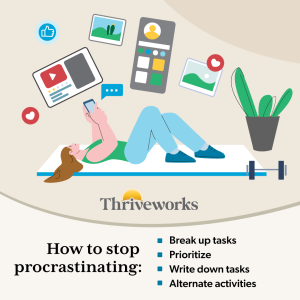Procrastination is a common work habit that most everyone engages in from time to time. It’s a habit that’s easy to get into, as the pattern of procrastination can build on itself and make it harder and harder to do things when you need to.
Whatever is causing you to procrastinate, there are many ways to stop the procrastination cycle and motivate yourself. Here are some tips on how to help yourself stop avoiding tasks and relieve some procrastination stress.
How Do I Stop Myself from Procrastinating?
There are multiple methods folks use to stop or limit themselves from procrastination. Some helpful examples are:
- Break up tasks. One of the more basic, though sometimes difficult, ways is to break things down into smaller tasks into small, easily achievable goals. When doing this, you may also need to plan out days and slots of time to work on the task in order to be mindful of when it is due.
- Write tasks down. Instead of trying to remember everything you have to do on your own and worrying that you’ll forget it, try writing out what you need to accomplish so you can stay on top of things and get work done on time. If you don’t tend to use to-do lists, planners can be helpful. You can also add in things that you want to do alongside your tasks, so you remember to take breaks. Planners are also great because they are more visual and allow you to strike it out as things get done, which can give you a sense of accomplishment.
- Alternate tasks. Alternating tasks is another common strategy. The idea behind this is that you work on something for a set period of time and then do something fun for a few minutes. Then you return to the task and continue working on it again. Taking breaks and breaking up time spent on tasks can help increase productivity.
- Prioritize. Think about the amount of time you have, decide what you have the energy to do, pick the most pressing tasks you have that align with your energy levels, and assign them to yourself for the day. This can help you feel less overwhelmed when you have a large to-do list or feel like there’s too much on your plate.
One of the best things you can do for yourself, though, is be kind to yourself. Aside from being a good practice, shame and stress are (most of the time) something like paralytics—they sap your energy and motivation, making it even harder to do the tasks you need to get done. By treating yourself kindly no matter how productive you are, you can stop that cycle of shame and blame and use the energy you were using to blame yourself on actually doing things.
You can also look at the different things that motivate you personally. In other words, why are you doing this task? There are two different types of motivation: intrinsic motivation and extrinsic motivation. In a nutshell, intrinsic motivation is about doing it because it is internally driven, such as doing it or because it fulfills a value you hold. Extrinsic motivation is about all things external, like doing things for a paycheck or because it is an expectation of a situation. Both types are needed to keep you going.

What Is the Main Cause of Procrastination?
At its core, procrastination is a result of negative beliefs that one holds, consciously or subconsciously, about oneself. As stated above, shame is the enemy of energy and motivation, and in large doses, it can be incredibly debilitating when you’re trying to get things done. It also tends to feed itself in a cycle—making it hard to do what needs to get done, feeling shameful that you didn’t do it faster or sooner, the increased stress and shame sapping more of your energy, etc.
Some factors that can contribute to procrastinating tendencies include:
- Anxiety
- Fear
- ADHD
- Perfectionistic tendencies
These can be accompanied by difficulty managing or regulating emotions. Boredom may or may not be a part of that equation as well.
What Are the 3 Most Common Types of Procrastination?
The three types of procrastination are:
- Classic procrastination: This type involves someone consciously delaying doing something they know they should be doing. This can be due to low energy, low self-esteem, and a variety of other factors, but it’s what most people think of when they think of “procrastination.”
- Creative avoidance: This type occurs when one becomes more creative in how they avoid tasks, doing other tasks—things that are less important than what’s being avoided but still need to get done—instead of the one(s) they should be doing. This can be a conscious choice, but it can also happen subconsciously, the mind seeking feelings of accomplishment in whatever way it can aside from doing the most important tasks.
- Priority dilution: This type happens when someone becomes overwhelmed with tasks and struggles to prioritize them correctly, with tasks that aren’t as important but perhaps still pressing taking priority and getting done before big or more important tasks.
Though they look like inaction and “laziness,” each of these types of procrastination has something driving them. Though there are ways to increase motivation and productivity, figuring out the source of one’s procrastinating tendencies is the best way to actually tame the impulse to procrastinate in the first place.
What Are 10 Ways to Stop Procrastinating? What Are 10 Procrastination-Busters?
Once you feel yourself starting to procrastinate on something or lose motivation to do the things you need to do, it can be hard to break the cycle. However, there are many helpful tools you can use to get yourself on track:
- Focus on the positive result of completing the task.
- Aim for excellence, not perfection.
- Have a friend, family member, or a work partner help you and hold you accountable.
- Use the 2-minute rule to generate some momentum.
- Change your environment to one that distracts you less.
- Use a planner to help you plan out larger projects and structure your day.
- Break the task down into manageable pieces.
- Alternate tasks/breaks.
- Focus on one thing at a time.
- Reward yourself for doing parts and for completing tasks (i.e. getting yourself a snack or a favorite drink).
Remember, these tricks are not a one-size-fits-all solution, and might need to be incorporated with other things to be the most effective. Find what works for you and implement those strategies where you can.
What Is the 2-Minute Rule to Avoid Procrastination?
The 2-minute rule is when you do a task, any task you need to get done, for 2 minutes. The idea is that it’ll take you less than 120 seconds to complete the task. Thus, you’ll generate some momentum and you’ll keep working beyond the 2 minutes. This strategy works especially well for tasks that have been around for a while and need to be completed.
An example of this would be washing the dishes. Most of the time, folks do not wash just one dish and call it a day. For some folks, working for two minutes feels unnatural, like they can’t get into the task. In this case, the idea is that you work on it for two minutes (or whatever) and assess where you are at the end of that time frame. If you feel up to it, then work on it for another set period of time and assess again. If you don’t feel up to it, then it’s okay to stop and come back to it sometime later, such as after lunch.
The reason it works this way is to avoid black-and-white thinking that makes tasks feel too big or time-consuming to get done (i.e. “It needs to be done in one go or it isn’t worth starting” or “I need to do it perfectly or it isn’t right”). Negative thoughts like that can get us stuck in a procrastination rut. By allowing yourself to work on something for just two minutes, the short time commitment makes the idea of starting the task much smaller, because you’re not committing to finishing it in this attempt.
Whether the two-minute rule gets you up and working and you find the energy to keep going beyond that or two minutes is all you have energy for that day, you still chipped away at what you needed to do. Again, some progress is better than no progress.
How to Stop Procrastinating Due to ADHD
When it comes to procrastination and ADHD, most of the same strategies given throughout this article work for procrastination. However, sometimes we need to work on refining both the intrinsic and extrinsic motivators.
Aside from those, though, one of the big ways to help reduce procrastination is to find ways to make tasks more enjoyable. It could be as simple as putting on a favorite album or show. It could also be as simple as turning it into a game: find out how long it took you to clean the kitchen last time and aim to do faster than you did previously.
Another part to be aware of is the negative thinking surrounding the task. Many different counseling theories state that the mind will take what we pay attention to, whether it’s “good” or “bad,” and continue to think about it, eventually reinforcing either negative or positive thoughts about ourselves in certain situations. With ADHD, patterns of procrastination start coming up in your childhood, so negative beliefs about your ability and motivation have years to take root and consistently get reinforced—especially if you are diagnosed later in life.
Show yourself some kindness. Focus on the parts that you’re doing well, even if it’s just the first few steps you completed. Some progress is better than no progress. Once you start letting go of what you should be doing or how you should be doing it, you’ll be able to figure out your own systems and tools for getting things done that work for you.













